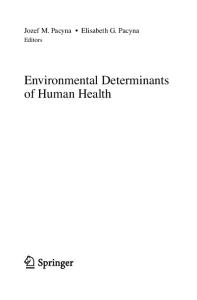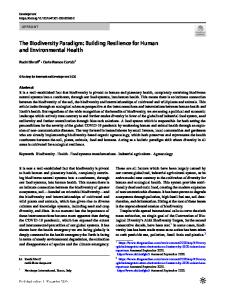Indoor Environmental Impact on Human Health
Following the discussion in Chap. 3, This Chapter focuses on the indoor built environment to provide a deeper understanding of how the built environment may have a causal relation to certain health outcomes. Five indoor variables are identified and their
- PDF / 5,476,468 Bytes
- 156 Pages / 453.544 x 683.151 pts Page_size
- 86 Downloads / 387 Views
Smart Technologies and Design For Healthy Built Environments
Smart Technologies and Design For Healthy Built Environments
Ming Hu
Smart Technologies and Design For Healthy Built Environments
123
Ming Hu School of Architecture, Planning & Preservation University of Maryland College Park, MD, USA
ISBN 978-3-030-51291-0 ISBN 978-3-030-51292-7 https://doi.org/10.1007/978-3-030-51292-7
(eBook)
© The Editor(s) (if applicable) and The Author(s), under exclusive license to Springer Nature Switzerland AG 2021 This work is subject to copyright. All rights are solely and exclusively licensed by the Publisher, whether the whole or part of the material is concerned, specifically the rights of translation, reprinting, reuse of illustrations, recitation, broadcasting, reproduction on microfilms or in any other physical way, and transmission or information storage and retrieval, electronic adaptation, computer software, or by similar or dissimilar methodology now known or hereafter developed. The use of general descriptive names, registered names, trademarks, service marks, etc. in this publication does not imply, even in the absence of a specific statement, that such names are exempt from the relevant protective laws and regulations and therefore free for general use. The publisher, the authors and the editors are safe to assume that the advice and information in this book are believed to be true and accurate at the date of publication. Neither the publisher nor the authors or the editors give a warranty, expressed or implied, with respect to the material contained herein or for any errors or omissions that may have been made. The publisher remains neutral with regard to jurisdictional claims in published maps and institutional affiliations. This Springer imprint is published by the registered company Springer Nature Switzerland AG The registered company address is: Gewerbestrasse 11, 6330 Cham, Switzerland
Foreword: Smart Technologies for a Healthy Built Environment
As an architect and neuroscientist I consumed Professor Ming Hu’s new book, on smart technologies and the built environment, with interest and pleasure. The book proves timely and strategic on numerous fronts, including through its comprehensive coverage of pressing issues concerning public and population health as well as its thought-provoking connections between design and wellness. Professor Hu methodically crafts and unfolds a compelling story concerning the responsibilities of architects to meaningfully foster the health of users of the built environment, while revealing vital links between design, technology, and duties around societal well-being. Beginning with early historical actors such as Hippocrates (do not harm) and Vitruvius (site, wind, light water), and ending with remarkable case studies of seminal contemporary buildings, Prof. Hu takes us on a rich journey across the centuries as architects endeavored to connect the ways we design with the impacts on people’s lives. Along this path many stories are told that capture and convey the developm
Data Loading...










